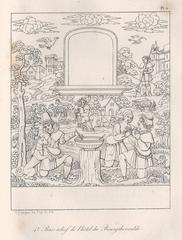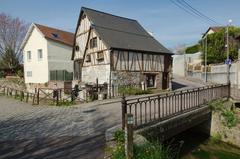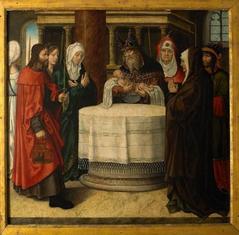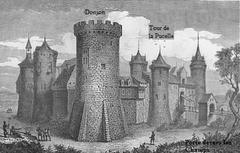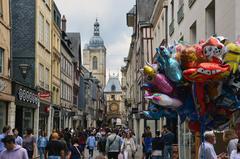
Church of Saint-Maclou Rouen: Visiting Hours, Tickets, and Historical Significance
Date: 03/07/2025
Introduction
The Church of Saint-Maclou in Rouen stands as an iconic testament to Flamboyant Gothic architecture and the city’s layered medieval heritage. Constructed primarily between 1437 and the early 16th century, it remains a symbol of Rouen’s religious, artistic, and communal vitality. Today, Saint-Maclou is not only an active place of worship but also a major cultural landmark, known for its intricate façade, striking spire, and luminous stained glass. This comprehensive guide provides everything you need to know for visiting, from practical details and travel tips to in-depth historical and architectural insights (France-Voyage, TouristPlatform, Normandie Lovers).
Table of Contents
- Historical Overview
- Visitor Information
- Highlights and Artistic Features
- Nearby Attractions and Travel Tips
- Preservation and Restoration
- Frequently Asked Questions (FAQ)
- Conclusion and Recommendations
- Sources and Further Reading
Historical Overview
Origins and Construction
The Church of Saint-Maclou was commissioned in 1437 to replace an earlier Romanesque church, reflecting the influence of Rouen’s prosperous merchant class. Construction continued for nearly a century, allowing the integration of evolving Gothic styles. The Le Roux family, among Rouen’s wealthiest, played a key role in financing the project, which culminated in 1517 with the completion of the main structure. The church’s design, attributed to several master builders, embodies the transition from Flamboyant Gothic exuberance to early Renaissance elements (France-Voyage, TouristPlatform).
Architectural Significance
Saint-Maclou is a masterpiece of the Flamboyant Gothic style, characterized by intricate stonework, flamboyant tracery, and soaring verticality. The western façade boasts a richly decorated porch with Renaissance-style wooden doors, while the plan follows a Latin cross with a nave, transept, and choir. The spire, reconstructed in the 19th century, rises 83 meters and dominates Rouen’s skyline. Inside, slender columns, high vaulted ceilings, and stained glass windows—including a Tree of Jesse and Crucifixion—underscore the church’s liturgical and artistic richness (France-Voyage).
Notable Events and Historical Role
Saint-Maclou’s history is intertwined with major events such as the Hundred Years’ War, the execution of Joan of Arc, and the devastations of World War II. Following wartime destruction, the church underwent extensive restoration, with phased projects completed through the early 21st century. It was recognized as a Historic Monument in 1840 and is part of Rouen’s UNESCO-listed historic center (TouristPlatform). The church also played a central role during plague outbreaks, with the adjacent Aître Saint-Maclou serving as a plague cemetery and site of collective mourning (Normandie Lovers).
Visitor Information
Visiting Hours
- General Hours: Daily, 9:00 AM to 6:00 PM (last admission 5:30 PM).
- Note: Hours may vary during religious holidays or special events. Confirm in advance on official tourism websites.
Tickets and Admission
- Entry: Free for individual visitors; no tickets or advance booking required.
- Donations: Appreciated to support preservation efforts.
- Guided Tours: Offered regularly (often in French and English) and can be booked via the tourist office or online. These may require a ticket.
Accessibility
- Ramps: Available at the main entrance; accessible restrooms provided.
- Interior: Some uneven flooring and steps may limit full access.
- Recommendation: Visitors with mobility concerns should contact the church in advance to arrange assistance.
Guided Tours
- Availability: Multilingual guided tours and audio guides are available and highly recommended for deeper insight.
- Booking: Reserve at the Rouen tourist office or online prior to your visit.
Highlights and Artistic Features
- Western Façade & Portals: Five gabled porches with biblical scenes and vegetal motifs, Renaissance-era wooden doors.
- Spire & Bell Tower: 83-meter spire, prominent in Rouen’s cityscape.
- Nave & Choir: Soaring vaults, a luminous nave, 17th-century “beam of glory” rood beam, and richly carved choir stalls.
- Stained Glass: 15th- and 16th-century windows depicting theological narratives.
- Sacristy: Neo-Renaissance with Italian marble columns.
The church’s sculptural program, including gargoyles and grotesques, conveys didactic messages and showcases the artistry of late Gothic Normandy.
Nearby Attractions and Travel Tips
- Aître Saint-Maclou: Former ossuary with macabre carvings, opposite the church.
- Rouen Cathedral: Gothic masterpiece, a short walk away.
- Place du Vieux-Marché: Historic square where Joan of Arc was executed.
- Quartier Saint-Maclou: Picturesque quarter with half-timbered houses and artisan shops.
Travel Tips:
- Wear comfortable shoes for cobbled streets.
- Visit early or late for fewer crowds and optimal photography.
- Public transport and parking facilities are nearby, with park-and-ride options for drivers.
Preservation and Restoration
Saint-Maclou’s survival is due to ongoing restoration efforts, particularly after WWII and throughout the late 20th and early 21st centuries. These works have focused on structural stabilization, cleaning, and stained glass restoration, ensuring the church’s continued use and accessibility.
Frequently Asked Questions (FAQ)
Q: What are the church’s opening hours?
A: Daily, 9:00 AM to 6:00 PM; variations possible during holidays.
Q: Is there an entrance fee?
A: No, entry is free. Donations are appreciated.
Q: Are guided tours available?
A: Yes, in multiple languages. Booking is recommended.
Q: Is the church accessible for visitors with reduced mobility?
A: Partially accessible; contact in advance for assistance.
Q: Can I take photographs inside?
A: Photography is permitted without flash; respect services and visitors’ privacy.
Conclusion and Recommendations
The Church of Saint-Maclou offers an immersive historical and artistic experience in the heart of Rouen. Its Flamboyant Gothic architecture, vibrant stained glass, and enduring role in the city’s spiritual life make it a must-visit, whether you are a history enthusiast, art lover, or casual traveler. Take advantage of guided tours, explore nearby attractions, and use digital resources like the Audiala app for an enriched visit.
For current hours and updates, consult the Normandy Tourism official site. Download the Audiala app for audio guides, maps, and local insights.





